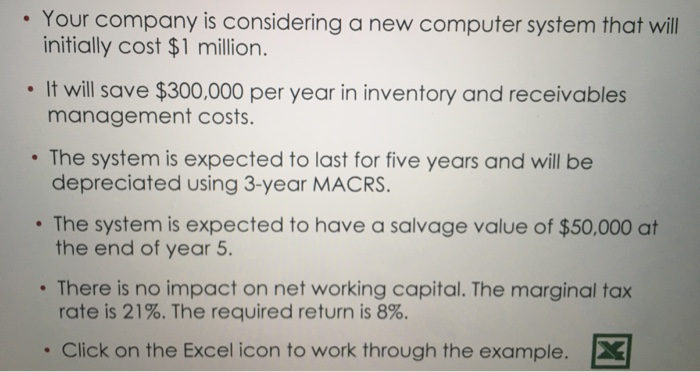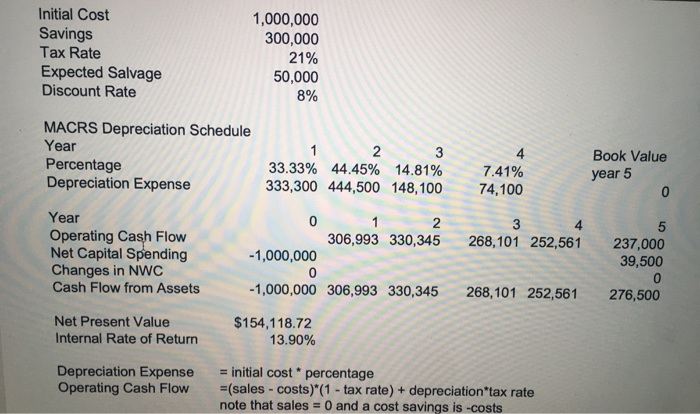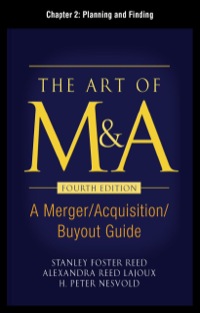



Your company is considering a new computer system that will initially cost $1 million. It will save $300,000 per year in inventory and receivables management costs. The system is expected to last for five years and will be depreciated using 3-year MACRS. The system is expected to have a salvage value of $50,000 at the end of year 5. There is no impact on net working capital. The marginal tax rate is 21%. The required return is 8%. . Click on the Excel icon to work through the example. X Initial Cost Savings Tax Rate Expected Salvage Discount Rate 1,000,000 300,000 21% 50,000 8% MACRS Depreciation Schedule Year Percentage Depreciation Expense Book Value year 5 33.33% 44.45% 14.81% 333,300 444,500 148, 100 7.41% 74,100 2 306,993 330,345 3 268,101 252,561 Year Operating Cash Flow Net Capital Spending Changes in NWC Cash Flow from Assets 237,000 39,500 -1,000,000 - 1,000,000 306,993 330,345 268,101 252,561 276,500 Net Present Value Internal Rate of Return $154,118.72 13.90% Depreciation Expense Operating Cash Flow = initial cost percentage =(sales - costs)*(1 - tax rate) + depreciation tax rate note that sales = 0 and a cost savings is -costs Learning Objectives 1. Understand how to use EXCEL Spreadsheet (a) Develop proforma Income Statement Using Excel Spreadsheet (b) Compute Net Project Cashflows, NPV, and IRR (c) Develop problem-solving and critical thinking skills and make long-term investment decisions $ 1) Life Period of the Equipment = 4 years 8) Sales for first year (1) 2) New equipment cost $ (200,000) 9) Sales increase per year 3) Equipment ship & install cost $ (35,000) 10) Operating cost (60% of Sales) 4) Related start up cost (5,000) (as a percent of sales in Year 1) 5) Inventory increase 25,000 11) Depreciation (Straight Line)/YR 6) Accounts Payable increase 5,000 12) Marginal Corporate Tax Rate (U) 7) Equip. salvage value before tax 15,000 13) Cost of Capital (Discount Rate) 200,000 5% (120,000) -60% (60,000) 21% 10% $ ESTIMATING Initial Outlay (Cash Flow, CFO, T=0) CFO CF1 CF2 CF3 CF4 Year Investments: 1) Equipment cost 2) Shipping and Install cost 3) Start up expenses Total Basis Cost (1+2+3) 4) Net Working Capital Total Initial Outlay Operations: Revenue Operating Cost Depreciation EBIT Taxes Net Income Add back Depreciation Total Operating Cash Flow XXXXX XXXXX XXXXX XXXXX $ Terminal: 1) Change in net WC 2) Salvage value (after tax) Total - $ - Salvage Value Before Tax (1-T) 20,000 XXXXX XXXXX Project Net Cash Flows $ - $ - $ NPV = IRR = Payback Q#1 Would you accept the project based on NPV, IRR? Would you accept the project based on Payback rule if project cut-off is 3 years? Q#2 Impact of 2017 Tax Cut Act on Net Income, Cash Flows and Capital Budgeting (Investment ) Decisions (a) Estimate NPV, IRR and Payback period of the project if equipment is fully depreciated in first year and tax rate equals to 21%. Would you accept or reject the project? (b) As a CFO of the firm, which of the above two scenario (a) or (b) would you choose? Why? Q#3 How would you explain to your CEO what NPV means? Q#4 What are advantages and disadvantages of using only Payback method? Q#5 What are advantages and disadvantages of using NPV versus IRR? Q#6 Explain the difference between independent projects and mutually exclusive projects. When you are confronted with Mutually Exclusive Projects and have coflicts with NPV and IRR results, which criterion would you use (NPV or IRR) and why? Your company is considering a new computer system that will initially cost $1 million. It will save $300,000 per year in inventory and receivables management costs. The system is expected to last for five years and will be depreciated using 3-year MACRS. The system is expected to have a salvage value of $50,000 at the end of year 5. There is no impact on net working capital. The marginal tax rate is 21%. The required return is 8%. . Click on the Excel icon to work through the example. X Initial Cost Savings Tax Rate Expected Salvage Discount Rate 1,000,000 300,000 21% 50,000 8% MACRS Depreciation Schedule Year Percentage Depreciation Expense Book Value year 5 33.33% 44.45% 14.81% 333,300 444,500 148, 100 7.41% 74,100 2 306,993 330,345 3 268,101 252,561 Year Operating Cash Flow Net Capital Spending Changes in NWC Cash Flow from Assets 237,000 39,500 -1,000,000 - 1,000,000 306,993 330,345 268,101 252,561 276,500 Net Present Value Internal Rate of Return $154,118.72 13.90% Depreciation Expense Operating Cash Flow = initial cost percentage =(sales - costs)*(1 - tax rate) + depreciation tax rate note that sales = 0 and a cost savings is -costs Learning Objectives 1. Understand how to use EXCEL Spreadsheet (a) Develop proforma Income Statement Using Excel Spreadsheet (b) Compute Net Project Cashflows, NPV, and IRR (c) Develop problem-solving and critical thinking skills and make long-term investment decisions $ 1) Life Period of the Equipment = 4 years 8) Sales for first year (1) 2) New equipment cost $ (200,000) 9) Sales increase per year 3) Equipment ship & install cost $ (35,000) 10) Operating cost (60% of Sales) 4) Related start up cost (5,000) (as a percent of sales in Year 1) 5) Inventory increase 25,000 11) Depreciation (Straight Line)/YR 6) Accounts Payable increase 5,000 12) Marginal Corporate Tax Rate (U) 7) Equip. salvage value before tax 15,000 13) Cost of Capital (Discount Rate) 200,000 5% (120,000) -60% (60,000) 21% 10% $ ESTIMATING Initial Outlay (Cash Flow, CFO, T=0) CFO CF1 CF2 CF3 CF4 Year Investments: 1) Equipment cost 2) Shipping and Install cost 3) Start up expenses Total Basis Cost (1+2+3) 4) Net Working Capital Total Initial Outlay Operations: Revenue Operating Cost Depreciation EBIT Taxes Net Income Add back Depreciation Total Operating Cash Flow XXXXX XXXXX XXXXX XXXXX $ Terminal: 1) Change in net WC 2) Salvage value (after tax) Total - $ - Salvage Value Before Tax (1-T) 20,000 XXXXX XXXXX Project Net Cash Flows $ - $ - $ NPV = IRR = Payback Q#1 Would you accept the project based on NPV, IRR? Would you accept the project based on Payback rule if project cut-off is 3 years? Q#2 Impact of 2017 Tax Cut Act on Net Income, Cash Flows and Capital Budgeting (Investment ) Decisions (a) Estimate NPV, IRR and Payback period of the project if equipment is fully depreciated in first year and tax rate equals to 21%. Would you accept or reject the project? (b) As a CFO of the firm, which of the above two scenario (a) or (b) would you choose? Why? Q#3 How would you explain to your CEO what NPV means? Q#4 What are advantages and disadvantages of using only Payback method? Q#5 What are advantages and disadvantages of using NPV versus IRR? Q#6 Explain the difference between independent projects and mutually exclusive projects. When you are confronted with Mutually Exclusive Projects and have coflicts with NPV and IRR results, which criterion would you use (NPV or IRR) and why










